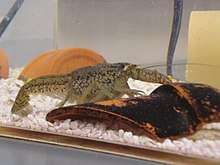Marbled crayfish
The marbled crayfish or Marmorkrebs, is a parthenogenetic crayfish that was discovered in the pet trade in Germany in the 1990s.[5] Marbled crayfish are closely related to the "slough crayfish", Procambarus fallax,[4] which is widely distributed across Florida.[6] No natural populations of marbled crayfish are known. Information provided by one of the original pet traders as to where the marbled crayfish originated was deemed "totally confusing and unreliable".[7] The informal name Marmorkrebs is German for "marbled crayfish".
| Marbled crayfish | |
|---|---|
 | |
| Adult marmorkrebs | |
| Scientific classification | |
| Kingdom: | |
| Phylum: | |
| Subphylum: | |
| Class: | |
| Order: | |
| Family: | |
| Genus: | |
| Species: | P. virginalis Lyko, 2017[1] |
 | |
| European countries where the Marmorkrebs has been found in the wild. It occurs also in France, Estonia, Madagascar, and Japan.[2][3] | |
| Synonyms | |
|
Procambarus fallax forma virginalis[4] | |
Model organism
Marbled crayfish are the only known decapod crustaceans to reproduce only by parthenogenesis.[5] All individuals are female, and the offspring are genetically identical to the parent.[8][9] Marbled crayfish are triploid animals,[8][10] which may be the main reason for their parthenogenetic reproduction. It is hypothesized that marbled crayfish originated from an error in meiosis resulting in a diploid gamete, which was then fertilized and created a viable triploid individual in a single generation.[8][11] Marbled crayfish are thus a model for the rapid generation of species.[8]
Because marbled crayfish are genetically identical, easy to care for,[12] and reproduce at high rates, they are a potential model organism, particularly for studying development.[13] A major drawback, however, is the long generation time (several months) compared to other research organisms.[14]
In 2018 the genome was sequenced, which provides an essential foundation for further research.[11]
Invasive species
Marbled crayfish have caused concern as a potential invasive species[5] because only a single individual is needed to establish a new population, and they can reproduce at high rates. They have since been introduced into natural ecosystems on four continents. They have been found in the wild in the following countries:
|
|
|
|
|
While initial reports of marbled crayfish in the wild in Europe consisted of only single individuals,[18] the number of European countries reporting populations of marbled crayfish is rising.[27]
The Madagascar population has grown rapidly,[23][11] causing concern among local authorities.[28]
Regulation
Marbled crayfish are one of the most widely distributed species of crayfish in the international pet trade[29][30][31] and release from aquariums has likely been the main source of unwanted introductions. Concerns about the potential damage from their introduction have prompted several jurisdictions to regulate ownership of marbled crayfish.
The European Union instituted "a total ban on the possession, trade, transport, production and release of these species [including the marbled crayfish] in the wild".[32][33][34][35]
Marbled crayfish are prohibited in the American states of Idaho,[36] Missouri,[37] Tennessee,[38][39] and Michigan,[40][41] and the Canadian province of Saskatchewan.[42]
References
- Lyko, Frank (2017). "The marbled crayfish (Decapoda: Cambaridae) represents an independent new species". Zootaxa. 4363 (4): 544–552. doi:10.11646/zootaxa.4363.4.6. PMID 29245391.
- Pârvulescu, Lucian; Togor, Andrei; Lele, Sandra-Florina; Scheu, Sebastian; Șinca, Daniel; Panteleit, Jörn (2017). "First established population of marbled crayfish Procambarus fallax (Hagen, 1870) f. virginalis (Decapoda, Cambaridae) in Romania" (PDF). BioInvasions Records. 6 (4): 357–362. doi:10.3391/bir.2017.6.4.09. Retrieved 2018-02-09.
- D. M. Holdich & M. Pöckl (2007). "Invasive crustaceans in European inland waters". In Francesca Gherardi (ed.). Biological Invaders in Inland Waters: Profiles, Distribution, and Threats. Dordrecht, Netherlands: Springer. pp. 29–75. doi:10.1007/978-1-4020-6029-8_2. ISBN 978-1-4020-6029-8.
- Peer Martin; Nathan J. Dorn; Tadashi Kawai; Craig van der Heiden; Gerhard Scholtz (2010). "The enigmatic Marmorkrebs (marbled crayfish) is the parthenogenetic form of Procambarus fallax (Hagen, 1870)". Contributions to Zoology. 79 (3): 107–118. doi:10.1163/18759866-07903003. Archived from the original (PDF) on 2011-05-21. Retrieved 2012-02-12.
- Gerhard Scholtz; Anke Braband; Laura Tolley; André Reimann; Beate Mittmann; Chris Lukhaup; Frank Steuerwald; Günter Vogt (2003). "Parthenogenesis in an outsider crayfish". Nature. 421 (6925): 806. Bibcode:2003Natur.421..806S. doi:10.1038/421806a. PMID 12594502.
- Horton H. Hobbs Jr. (1942). "The crayfishes of Florida". University of Florida Publication: Biological Series. 3 (2): 1–179.
- Günter Vogt, Laura Tolley & Gerhard Scholtz (2004). "Life stages and reproductive components of the Marmorkrebs (marbled crayfish), the first parthenogenetic decapod crustacean". Journal of Morphology. 261 (3): 286–311. doi:10.1002/jmor.10250. PMID 15281058.
- Vogt, Günter; Falckenhayn, Cassandra; Schrimpf, Anne; Schmid, Katharina; Hanna, Katharina; Panteleit, Jörn; Helm, Mark; Schulz, Ralf; Lyko, Frank (2015). "The marbled crayfish as a paradigm for saltational speciation by autopolyploidy and parthenogenesis in animals". Biology Open. 4 (11): 1583–1594. doi:10.1242/bio.014241. PMC 4728364. PMID 26519519.
- Peer Martin, Klaus Kohlmann & Gerhard Scholtz (2007). "The parthenogenetic Marmorkrebs (marbled crayfish) produces genetically uniform offspring". Naturwissenschaften. 94 (10): 843–846. Bibcode:2007NW.....94..843M. doi:10.1007/s00114-007-0260-0. PMID 17541537.
- Martin P, Thonagel S, Scholtz G (2015). "The parthenogenetic Marmorkrebs (Malacostraca: Decapoda: Cambaridae) are triploid organisms". Journal of Zoological Systematics and Evolutionary Research. 54: 13–21. doi:10.1111/jzs.12114.
- Gutekunst, Julian; Andriantsoa, Ranja; Falckenhayn, Cassandra; Hanna, Katharina; Stein, Wolfgang; Rasamy, Jeanne; Lyko, Frank (2018-02-05). "Clonal genome evolution and rapid invasive spread of the marbled crayfish". Nature Ecology & Evolution. 2 (3): 567–573. doi:10.1038/s41559-018-0467-9. ISSN 2397-334X. PMID 29403072.
- Stephanie A. Jimenez & Zen Faulkes (2010). "Establishment and care of a laboratory colony of parthenogenetic marbled crayfish, Marmorkrebs". Invertebrate Rearing. 1 (1): 10–18.
- Frederike Alwes & Gerhard Scholtz (2006). "Stages and other aspects of the embryology of the parthenogenetic Marmorkrebs (Decapoda, Reptantia, Astacida)". Development Genes and Evolution. 216 (4): 169–184. doi:10.1007/s00427-005-0041-8. PMID 16389558.
- Günter Vogt (2010). "Suitability of the clonal marbled crayfish for biogerontological research: A review and perspective, with remarks on some further crustaceans". Biogerontology. 11 (6): 643–669. doi:10.1007/s10522-010-9291-6. PMID 20582627.
- Jiří Patoka; Miloš Buřič; Vojtěch Kolář; Martin Bláha; Miloslav Petrtýl; Pavel Franta; Robert Tropek; Lukáš Kalous; Adam Petrusek; Antonín Kouba (2016). "Predictions of marbled crayfish establishment in conurbations fulfilled: Evidences from the Czech Republic". Biologia. 71 (12): 1380–1385. doi:10.1515/biolog-2016-0164.
- Ercoli, F.; Kaldre, K.; Paaver, T.; Gross, R. (2019). "First record of an established marbled crayfish Procambarus virginalis (Lyko, 2017) population in Estonia". BioInvasions Records. 8 (3): 675–683. doi:10.3391/bir.2019.8.3.25.
- Collas, Marc (2019). "The marbled crayfish (Procambarus virginalis) has just been discovered in France on the basin of the river Moselle. This is the first observation of this species in France". Retrieved 2019-08-31.
- Peer Martin; Hong Shen; Gert Füllner; Gerhard Scholtz (2010). "The first record of the parthenogenetic Marmorkrebs (Decapoda, Astacida, Cambaridae) in the wild in Saxony (Germany) raises the question of its actual threat to European freshwater ecosystems". Aquatic Invasions. 5 (4): 397–403. doi:10.3391/ai.2010.5.4.09.
- Christoph Chucholl & Michael Pfeiffer (2010). "First evidence for an established Marmorkrebs (Decapoda, Astacida, Cambaridae) population in Southwestern Germany, in syntopic occurrence with Orconectes limosus (Rafinesque, 1817)". Aquatic Invasions. 5 (4): 405–412. doi:10.3391/ai.2010.5.4.10.
- Lőkkös A, Müller T, Kovács K, Várkonyi L, Specziár A, Martin P (2016). "The alien, parthenogenetic marbled crayfish (Decapoda: Cambaridae) is entering Kis-Balaton (Hungary), one of Europe's most important wetland biotopes". Knowledge and Management of Aquatic Ecosystems. 417 (417): 16. doi:10.1051/kmae/2016003.
- Francesco Nonnis Marzano, Massimiliano Scalici, Stefania Chiesa, Francesca Gherardi, Armando Piccinini & Giancarlo Gibertini (2009). "The first record of the marbled crayfish adds further threats to fresh waters in Italy". Aquatic Invasions. 4 (2): 401–404. doi:10.3391/ai.2009.4.2.19.CS1 maint: multiple names: authors list (link)
- Tadashi Kawai; M. Takahata, eds. (2010). The Biology of Freshwater Crayfish. Sapporo: Hokkaido University Press. ISBN 978-4-8329-8194-2.
- Julia P. G. Jones; Jeanne R. Rasamy; Andrew Harvey; Alicia Toon; Birgit Oidtmann; Michele H. Randrianarison; Noromalala Raminosoa; Olga R. Ravoahangimalala (2008). "The perfect invader: a parthenogenic crayfish poses a new threat to Madagascar's freshwater biodiversity". Biological Invasions. 11 (6): 1475–1482. doi:10.1007/s10530-008-9334-y.
- Boris Lipták; Agata Mrugała; Ladislav Pekárik; Anton Mutkovič; Daniel Gruľa; Adam Petrusek & Antonín Kouba (2016). "Expansion of the marbled crayfish in Slovakia: beginning of an invasion in the Danube catchment?". Journal of Limnology. doi:10.4081/jlimnol.2016.1313.
- P. Bohman; L. Edsman; P. Martin; G. Scholtz (2013). "The first Marmorkrebs (Decapoda: Astacida: Cambaridae) in Scandinavia". BioInvasions Records. 2 (3): 227–232. doi:10.3391/bir.2013.2.3.09.
- RA Novitsky; MO Son (2016). "The first records of Marmorkrebs [Procambarus fallax (Hagen, 1870) f. virginalis] (Crustacea, Decapoda, Cambaridae) in Ukraine". Ecologica Montenegrina. 5: 44–46.
- C. Chucholl; K. Morawetz; H. Groß H (2012). "The clones are coming – strong increase in Marmorkrebs [Procambarus fallax (Hagen, 1870) f. virginalis] records from Europe". Aquatic Invasions. 7 (4): 511–519. doi:10.3391/ai.2012.7.4.008.
- Klaus Heimer (18 August 2010). "Invasion of self-cloning crayfish alarms Madagascar". Deutsche Presse-Agentur wire story.
- Zen Faulkes (2010). "The spread of the parthenogenetic marbled crayfish, Marmorkrebs (Procambarus sp.), in the North American pet trade". Aquatic Invasions. 5 (4): 447–450. doi:10.3391/ai.2010.5.4.16.
- Zen Faulkes (2015). "Marmorkrebs (Procambarus fallax f. virginalis) are the most popular crayfish in the North American pet trade". Knowledge and Management of Aquatic Ecosystems. 416 (416): 20. doi:10.1051/kmae/2015016.
- Zen Faulkes (2015). "The global trade in crayfish as pets". Crustacean Research. 44: 75–92. doi:10.18353/crustacea.44.0_75.
- "REGULATION (EU) No 1143/2014 OF THE EUROPEAN PARLIAMENT AND OF THE COUNCIL of 22 October 2014 on the prevention and management of the introduction and spread of invasive alien species". EUR-Lex. Retrieved 2018-02-09.
- "COMMISSION IMPLEMENTING REGULATION (EU) 2016/1141 of 13 July 2016 adopting a list of invasive alien species of Union concern pursuant to Regulation (EU) No 1143/2014 of the European Parliament and of the Council". EUR-Lex. Retrieved 2018-02-09.
- "COMMISSION IMPLEMENTING REGULATION (EU) 2017/1263 of 12 July 2017 updating the list of invasive alien species of Union concern established by Implementing Regulation (EU) 2016/1141 pursuant to Regulation (EU) No 1143/2014 of the European Parliament and of the Council". EUR-Lex. Retrieved 2018-02-09.
- Zen Faulkes (February 17, 2016). "Has the European Union regulated Marmorkrebs?". Marmorkrebs blog. Retrieved May 4, 2016.
- "Invertebrates — Invasive Species of Idaho". idaho.gov. Retrieved 2020-01-02.
- Anonymous (17 May 2010). "Conservation Action Meeting of the March 2010 Conservation Commission". Missouri Department of Conservation. Archived from the original on 23 September 2010. Retrieved November 28, 2010.
- "Rules of the Tennessee Wildlife Resources Agency, Wildlife Resources, Chapter 1660-1-18, Rules and Regulations of Live Wildlife" (PDF). Tennessee Wildlife Resources Agency. 2015-10-01. Retrieved 2010-05-27.
- Zen Faulkes (January 25, 2016). "Sell your Marmorkrebs, Tennesseans". Marmorkrebs blog. Retrieved January 25, 2016.
- "Invasive, self-cloning marbled crayfish now a prohibited species in Michigan". The Department of Natural Resources, Michigan. 2020-05-15. Retrieved 2020-05-27.
- Ken Haddad (2020). "Michigan adds invasive marbled crayfish to prohibited species list". Click On Detroit. Retrieved 2020-05-15.
- "The Saskatchewan Gazette". 2020-04-03. p. 193. Retrieved 2020-05-27.
External links
| Wikimedia Commons has media related to |
- Marmorkrebs.org
- "Procambarus fallax f. virginalis (Marmorkrebs)". Invasive Species Compendium. CAB International.